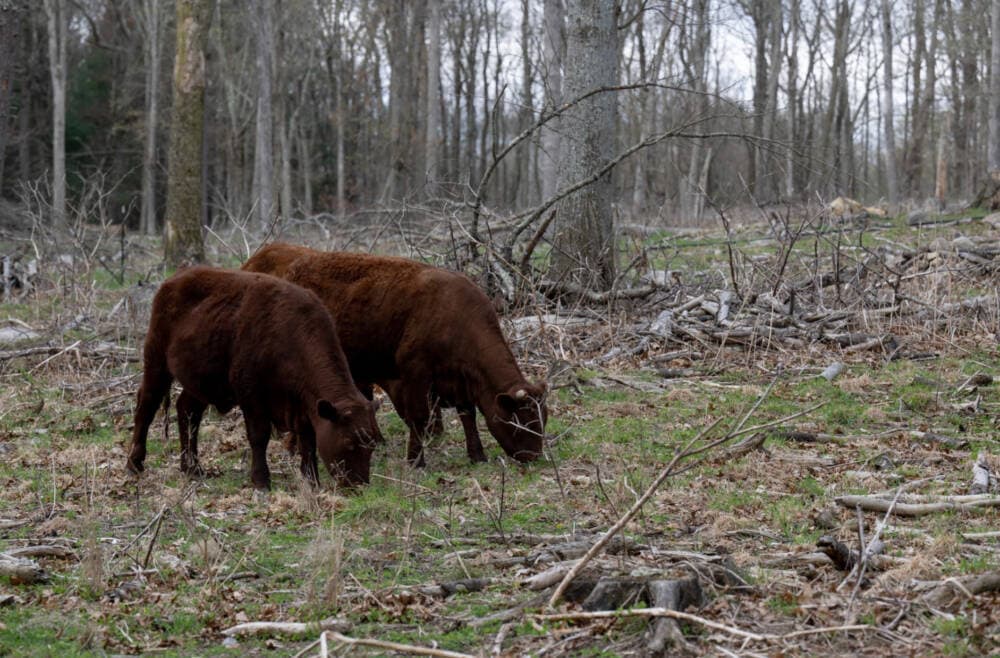Advertisement
For New England farmers, silvopasture could be a key adaptation to a changing climate

To understand silvopasture, imagine you’re a cow grazing under full sun on a hot August day.
It’s 95 degrees and the humidity is brutal. “Do you want to be out there eating a full buffet?” asked Joe Orefice, a beef cattle farmer at Hidden Blossom Farm in northeastern Connecticut. “You don't want to do that. As a human, you're gonna be like, ‘This is miserable.’”
But Orefice’s cows aren’t actually eating in an open field. They're in the comfortable shade of carefully spaced trees. Healthy trees get bigger. Soil conditions are better. And more sunlight hits the forest floor, allowing grass to grow lush and green.
That’s silvopasture.
“Silvopasture is the intentional integration of livestock, trees and forage on the same unit of land,” said Orefice, who is also a lecturer at the Yale School of the Environment. “Trees are producing a crop, the grass is producing a crop, which is feeding the livestock. And all of those are managed.”
The nonprofit Project Drawdown, which focuses on what it calls “science-based climate solutions,” lists silvopasture as a top global solution for climate change.
It’s not a new idea, but it’s starting to gain momentum in New England.
Orefice said integrating trees into his pasture makes for shaded, happier cows that produce more. The trees produce too, yielding fruits or syrup that can translate into extra income.
And silvopasture has another key benefit: the whole system is more resilient to climate change.
“When you have a drought, the grass in a treeless pasture just stops. Last summer, 2022, it was dry. I was still grazing,” Orefice said. “Well, my cows are still grazing. I don't eat grass. But the cows are grazing. And that was because I had silvopasture.”
Advertisement
As record drought gripped much of the U.S. last year, the National Oceanic and Atmospheric Administration said five of the six New England States saw record warm temperatures.
“There are times when I go to a farm site visit, where I feel scared on behalf of those farmers, because most farms are not well prepared for what's coming,” said Meghan Giroux, with Interlace Commons, an organization that helps farmers in the northeast start silvopastures.
“Farms are communicating that they’re experiencing longer periods of drought and shorter periods of precipitation, but those periods of precipitation are very intense.”
Giroux said more farmers want to do silvopasture as they face the reality of climate change.
Intense precipitation can erode soil and drought can shorten grazing, meaning farmers pay more for animal feed. The latest report from the Intergovernmental Panel on Climate Change said continued global warming will only make things worse.
“If there is one, or two, or three drought years simultaneously, farmers are the biggest ones to lose,” said Yusuf Jameel, an associate scientist with Project Drawdown.
Part of the reason his organization sees silvopasture as a major solution, Yusuf said, is because pasture fields are everywhere.
“Silvopasture can be implemented in total land for about 823 million hectares. So that's a huge amount of land,” Yusuf said. “When you can implement a solution globally, it makes it super powerful.”
He said carbon in trees and soil is much better than in the atmosphere. And that harvesting crops like apples or nuts from trees in silvopastures means farmers can sell more.
In heavily-forested New England, creating silvopasture often involves thinning out trees. Orefice said that’s rarely carbon positive, but is still better than creating a pasture by clear-cutting a forest.
Ben Coerper, who farms at Wild Harmony Farm in Rhode Island, said silvopasture is all about balancing concerns for the climate against the economic uncertainty of being a farmer.
“We call it our drought insurance policy,” Coerper said.
Today, he pastures beef cattle on about 60 acres of land. He’s converted about half to silvopasture. He rents the farmland and said silvopasture has another benefit, it can make land more affordable.
“If you look at the cost of land rent, as a farmer,” he said, “you might pay $300 an acre for an open field. You might only have to pay $20 an acre for forest.”
For Coerper, silvopasture is all about balance: combining the carbon-storing power of trees with a local food production system that’s protecting his farm against the threats posed by climate change.
“Silvopasture is … a very clear answer,” he said, “where we can keep the carbon sequestering trees out there, and then also be producing food underneath it.”
This story is a production of the New England News Collaborative and is part of the collaborative's Earth Week series. It was originally published by Connecticut Public.
This segment aired on April 21, 2023.